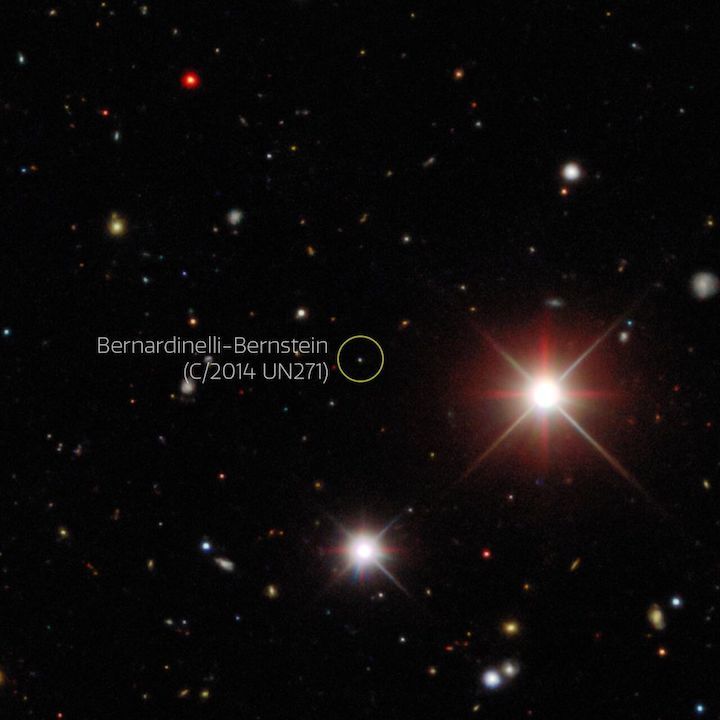13.02.2022
The 85-mile-wide Bernardinelli-Bernstein comet is winging its way toward the interior of the solar system.

An image taken by the Dark Energy Survey shows Comet Bernardinelli-Bernstein in October 2017. (Image credit: Dark Energy Survey/DOE/FNAL/DECam/CTIO/NOIRLab/NSF/AURA/P. Bernardinelli & G. Bernstein (UPenn)/DESI Legacy Imaging Surveys. Acknowledgments: T.A. Rector (University of Alaska Anchorage/NSF’s NOIRLab)/M. Zamani (NSF’s NOIRLab)/J. Miller (NSF’s NOIRLab))
The Bernardinelli-Bernstein comet, identified in 2021, is officially the biggest comet ever observed.
The new record, reported on the preprint website arXiv and now accepted for publication in the journal Astronomy and Astrophysics Letters, bumps the Hale-Bopp comet from the top spot. Hale-Bopp was discovered in 1995 and became visible to the naked eye in 1996; it was about 46 miles (74 kilometers) across. Comet Bernardinelli-Bernstein, also known as comet 2014 UN271, has now been calculated to be about 85 miles (137 km) across.
The Bernardinelli-Bernstein comet is named after its discoverers, University of Pennsylvania cosmologist Gary Bernstein and University of Washington postdoctoral scholar Pedro Bernardinelli, who first spotted the comet in the Dark Energy Survey dataset. The images showing the comet date back to 2014, which is why that year is in the comet's official scientific designation. Bernardinelli and Berstein noticed the tiny dot moving as they studied images from subsequent years.
At that time, the comet was too distant for researchers to get a good gauge on its size, though they could tell it was likely quite large. The comet hails from the Oort Cloud, a cloud of chunks of ice and rock hovering at the edge of the solar system. Its orbit takes it as far as a light-year from the sun — and takes 5.5 million years to complete.
The comet is currently winging its way toward the interior of the solar system. It will get closest to Earth in 2031, though not too close for comfort: The comet will remain just outside Saturn's orbit, Live Science reported.
The new research was led by Emmanuel Lellouch, an astronomer at the Observatoire de Paris, and used data from the Atacama Large Millimeter Array in South America, taken in August 2021 when the comet was 19.6 AUs away. (An AU is the distance between the Earth and the sun and translates to about 93 million miles, or 150 million kilometers.) Researchers studied the microwave radiation coming off the comet's bulk. From these reflected light wavelengths, the team could infer the comet's size. This is the longest distance at which this type of measurement has been done before, the researchers wrote in their new paper.
It's exciting to get a measurement while the comet is still so distant, the researchers added, because Bernardinelli-Bernstein will likely shrink significantly by the time it gets closer to Earth. As the comet gets closer to the sun, its tail of dust and gas will expand, and its main body will melt and shrink.
The comet will not be visible to the naked eye, as Hale-Bopp was at its closest approach, but scientists expect to learn a lot about Oort Cloud objects from the visitor. Large telescopes like the Atacama Array will allow scientists to learn more about the chemical composition of the comet as it passes, Lellouch and his colleagues wrote. They should also know more soon about the comet's temperature, spin and shape.
Quelle: SC
